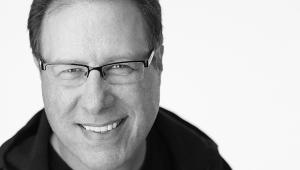Photography Q&A: Pro Shooter Scott Kelby Answers Your Photo Questions

Q. I have a Canon EOS 5D Mark III and a Canon EOS 7D. For sports and nature I use the 7D with a Canon 100-400mm f/4.5-5.6L Mark II lens. With the Canon 7D APS sensor it makes the lens about a 150-600mm. Would I get better quality if I bought a Canon EOS 5D Mark IV, used the Canon 100-400mm lens, and cropped the image in Photoshop?
A. The Canon EOS 5D Mark IV absolutely makes better quality images than the 7D, but you’ll be losing some range. While you could crop in closer, for sports and wildlife, which are both usually shot in pretty decent light, I think your best bet might be to upgrade to the Canon 7D Mark II instead—it’s a lot less expensive. Plus, you’d still get the extra reach of the crop sensor, but the Mark II is a massive upgrade to the original 7D, and sports and wildlife are its sweet spots. That’s the route I would go.
Q. I’ve always been told that to get the background behind your subject blurry you need to use your most wide-open f/stop, but using my 24-70mm, even at f/2.8, the background is only slightly blurry if at all. Is there a problem with my lens?
A. There’s probably nothing wrong with your lens itself, but more of a problem with your choice of lens for what you want to do. What you heard about the f/stop part is correct, but it’s only half of the technique, especially with a lens like the 24-70mm. You need to use a wide-open f/stop, like f/2.8, but you can also use f/4, and even f/5.6, if you do the second part of this technique correctly, which is to zoom in tight. So, remember to use a “wide-open f/stop and zoom in tight.” With a 24-70mm lens at any wide angle, like 24mm or 35mm, you are going to have to put your subject really close in the foreground to get that background blurry. Even at 70mm, unless you’re really close to your subject, the background isn’t going to be as soft and blurry as you’d hope. You’re going to need a longer lens (at least an 85mm or longer) to get the look I think you’re trying to achieve. In the meantime, start getting really, really close to your subject.
Q. As a street photographer I am consistently faced with choosing between a single focus point vs. the full spectrum of focus points, and doing it quickly. I’m using a Nikon D3200 set to back-focusing. Ideally, I’d like the following option: one click = single focus point, two clicks = multiple focus points. Any thoughts?
A. I use just nine focus points for street photography and a lens that focuses quickly. The downside of using the full spectrum is that it might focus on the wrong subject in a busy street scene, and the nine-point focus is well suited to things that move in a pretty predictable pattern, like walking. Also, unless you’re getting a bunch of out-of-focus photos, you’re better off concentrating on the scene you’re standing in front of and capturing the moment than you are switching or changing camera settings on the fly. You’ll get better results by looking more and messing with the camera less.
Q. I’m using a Nikon D750 with a Nikkor 300mm f/4E PF prime lens coupled with a Nikon 1.4x teleconverter. I’m getting wonderful photos, but there are many times that isn’t enough reach. I’ve been trying to find info on digiscoping, primarily what grade photos can be accomplished via this method. I see lots of digiscoped pics, but no one says from what distance they were shot. Can you advise?
A. I haven’t used a digiscope myself, so I won’t be able to speak to that, but what you might consider instead is renting a lens for your trip (in your e-mail you said you were planning a trip to Costa Rica). For example, you could rent a Nikkor 500mm f/4, which is super sharp and isn’t nearly as heavy as some other monster-sized lenses. Plus, you could add the Nikon TC-14E II 1.4x teleconverter to it and you’d effectively have around a 700mm lens, but I don’t know if you’ll even need to go that far—just the 500mm itself will get you a lot closer.
Q. Is it better to have image stabilization in your camera or in the lens?
A. There are a long list of advantages and disadvantages to both, but one huge disadvantage is that at this point both Canon and Nikon don’t offer in-camera stabilization in their DSLRs, so it really limits your choices. Sony has models that support in-camera stabilization (most notably their mirrorless cameras), but not all Sony models. It should be noted, though, it is in Sony’s new A99 II DSLR-like camera, so they’re definitely moving in that direction. A big advantage of in-camera stabilization is that any lens you put on it will be stabilized, and if you have an electronic viewfinder, you can see the stabilization as you’re shooting. A big disadvantage of in-camera stabilization is that it doesn’t work nearly as well on medium to long lenses. So, it’s a trade-off, and one that might not matter if you don’t often use medium to long lenses.
Q. I would like to know why whenever you see infrared photos it’s always during the full green season. Why not shoot in the fall when the leaves and everything is losing its greenery?
A. That’s a question you’d have to ask the photographers who shoot infrared. Maybe they all live in Florida, or Hawaii, where the grass is always greener. ;-) In all seriousness, I love how infrared reacts to nice green trees, and I imagine I’m not alone. If I see beautiful fall colors and the change of season, the last thing I want to do is shoot infrared—that’s when I would reach for my full color camera. Again, that’s just me, but I imagine I’m not alone on this one.
Scott Kelby is a photographer, Photoshop Guy, award-winning author of more than 50 books, and CEO of KelbyOne, an online education community dedicated to helping photographers take the kinds of images they’ve always dreamed of. You can learn more about Scott at his daily blog (scottkelby.com), or follow him on Twitter: @scottkelby.
Editor’s Note: Ask a Pro is a Q&A column from professional photographer, writer, and educator Scott Kelby. Scott is here to answer all your photography-related questions, so if you have something you’d like to know, e-mail him at editorial@shutterbug.com (with “For Scott Kelby” as the subject line) and your query could be featured in the next edition of Ask a Pro.
















































